How to Draw Shadows |
||||||||||||||||
|
Page 16 / 25
 CHAPTER XV PERSPECTIVE OF SHADOWSTHERE is a good reason for understanding the principle of shadows ; though it is not always realised by students. You may have thought of a fine subject, and yet miss valuable features that would have been suggested by perspective, as the subject unravels itself from the first hazy idea. For instance, a dramatic subject might be a shrine lit by a single light and approached by steps ; on them a figure, seen from behind, in a supplicating attitude. The light throwing radiating shadows down the steps would just add the mystery and bigness necessary for the subject. Out of doors we see somewhat similar radiating shadows from tree trunks between us and the setting sun. We ought at least to know the bare rules governing these two types of shadows. The shape of a shadow will at times convey our meaning better than the object itself. Have we not seen pictures of cloaked and hatted conspirators round a table, their guttering rushlight throwing fantastic shadows on the wall that were more expressive of their evil machinations than the plotters themselves ? Again a shadow may be thrown from things hidden from view and thus explain their shape. Or a shadow from some trifling object may bring out the good points, or least explain the form or surface of the plane it is cast on. The rules usually given for drawing shadows are many and complicated. Looking at numerous examples under varying conditions is a pastime apt to deter one from learning the underlying principles. Therefore I tried to confine myself to the most simple object—the side of a wall—for each example, in order to show how the shadow would be obtained under some of the more usual conditions of lighting. The monotony of that reiterated blank wall forced me to add other diagrams to demonstrate the practical use of the rule. SHADOWS FROM THE SUN (1) Sun on one side of the subject. — Suppose the sun on our left ; the ground level, an upright wall receding from us. If the sun is not in front, or behind us, its rays will travel in parallel lines. Then lines of light, since they cannot pass through the wall, travel over the top. Where they strike the ground the shadow from the wall ceases.
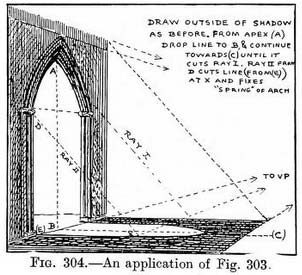
(2) Ground sloping from the object that throws the shadow. — Using our same wall, let us make the ground slope evenly (and always at the same inclination) from the wall. The rays of light must be continued until they meet the ground—the only difference between Figs. 303 and 305 is in the greater length of the shadow.
Example. — The shadow of a chimney on a sloping roof.
This leaves the mind free to appreciate and render the fine outlines of shadow that unevenness of the ground or the shape of the object make manifest. This is more especially the case when single objects or detached groups cast their shadows. Each shadow dips into a hollow and rises over each contour ; becomes foreshortened on the far edge of a slope, or hidden by a projection that catches the sun. Mathematical accuracy is not required so long as general truth is observed and the beauty to be found in lines is given full play. SUN IN FRONT OF US (1) Sun throwing shadows towards us. — On level ground when the sun is in front of us, or rather in any position except behind us, or to the side of our subject ; then its rays are no longer to be drawn parallel. They must radiate from the sun, or if you prefer it, must have the sun for their vanishing point.
(2) Shadow on ground sloping towards us. — The V.P. for the shadows will (as in the last case) be directly beneath the sun, but instead of being at the height of the horizon, will be at the same height (not necessarily in the same place) as the V.P. for the ground. Practice for Fig. 308. — Draw the object, the ground, the sun, and a vertical dropped from it. Find the " uphill " V.P. for the ground ; at the same height mark the V.P. for shadows on the vertical (i.e. under the sun). Draw rays. Under the top points of the object touched by rays mark ground. From " shadow " V.P. draw lines to ground marks and continue. Join meeting points of rays and ground as in last case. 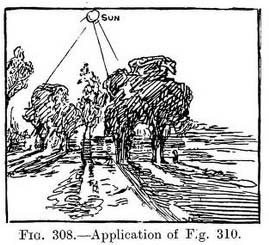
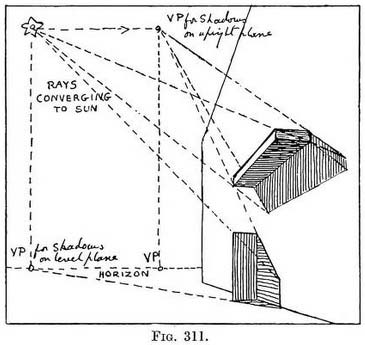
SUN BEHIND THE PAINTER
(A) Shadow from a vertical object cast on level ground. Subject. — A wall rather to one side, facing us, and lit by the sun so that we see its shadow on the ground behind it. Practice for Fig. 313. — Copy (Fig. 312) the direction of one side of the receding shadow (1-2) and continue it till it meets the horizon. This will be the " shadow " V P Immediately under it and at the same distance below the horizon as the sun is above it, mark the pseudo-sun. From it carry a ray to the top of the upright (to 4) whose shadow has been drawn. The ray will cut off the shadow and determine its correct length. Connect other ground points with the " shadow " V.P., and cut them off by rays from pseudo-sun to top of uprights above them. 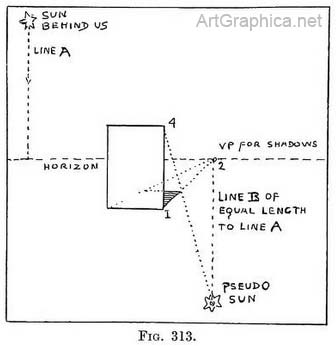
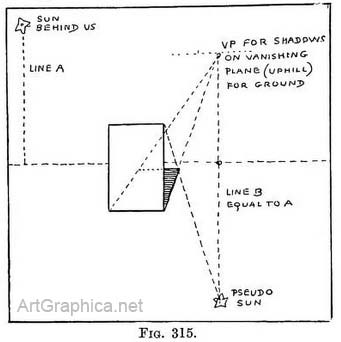
Practice (Fig. 315). — Draw the object, the sloping ground, the transposed sun, and the edge of one shadow. Continue the line of the shadow until it reaches a point immediately above the pseudo-sun, and at the height of the V.P. for the sloping ground. That point is now the V.P. for shadows. Find their direction by lines to the " shadow " V.P., and their length by rays from the pseudo-sun as in former exercises. 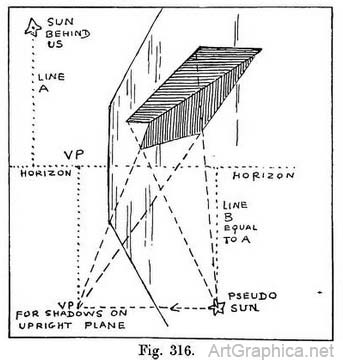 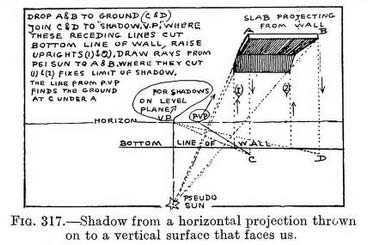
(C) The shadow of a projection from a receding upright. EXAMPLES.—Shadows cast on steps.
(2) Sun behind painter (Fig. 319). — The length of the shadow is determined by the rays from pseudo-sun (see Fig. 313 if diagram does not explain itself). (3) Sun in front of painter. — The shadow on the tread of each step is found as in Fig. 307. When the shadow reaches the edge of the step it is taken vertically down the rise " and continued over the next tread again as in Fig. 320. Shadow cast by a leaning object.
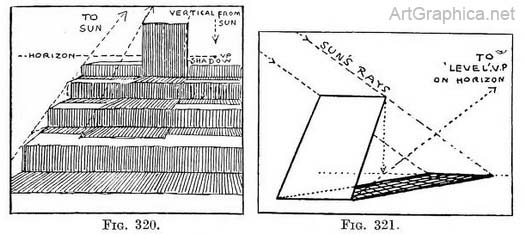
ARTIFICIAL LIGHT AND DAYLIGHT The light and shade of objects under artificial light resembles that of sunlight in the sparkling intensity of the lights and the defined forms of the shadows. It differs from it in the greater distortion in the forms of shadows. The one will never be confused with the other by reason of the even luminosity of far and near objects under sunlight, as opposed to the rapid fading in the brightness of objects that are more distant from the source of artificial illumination. Joseph Wright, in his picture of the air-pump, made judicious use of variety of lighting from a simple candle to accentuate the expression of the faces. Rembrandt delighted in the mystery of candlelight. His painting of the " Nativity," apart from its emotional side of the subject, but just looked at as an ordinary interior of a stable lit by a lanthorn, shows how much mystery and greatness he saw in everyday effects. SHADOWS FROM ARTIFICIAL LIGHT
Shadows from artificial light when thrown on top of a level surface differ from those cast by the sun in having their V.P. under the light itself (Fig. 323). For instance, some objects on a table that sun shadows owing to the vast might be lit by the sun in front of us. Their shadows on the table would all point towards a V.P. on the far away horizon and under the sun.
Consequently, with shadows under artificial lighting there is a violent distortion of the form of the object that does not occur under the illumination of the sun. (1) Shadows from objects under artificial light on level surfaces. It stands to reason that objects will cast their shadows away from the light ; those that are situated behind the light will have shadows receding from us, while others between us and the light will cast shadows towards us. As the same recipe is used for all shadows thrown from objects that stand on level ground we need not detail each circumstance. Remember to carry a vertical down from the light until it meets the surface the shadows will be on. The " shadow " V.P. is the junction of that vertical with the level plane.
Practice for Fig. 324. — Draw the object, the ceiling, the light. Raise a vertical line from the light until it touches the ceiling directly above it. There place the " shadow " V.P. Carry rays from light over ends of object that juts out from the ceiling. Join " shadow " V.P. with each corner of object touching the ceiling, and continue these lines till they meet the rays. Now turn the diagram upside-down, and you recognise that the work performed is exactly the same as when the object stood on the ground and the light was from above. The only troublesome part about it is in placing the spot on the ceiling directly above the light. This may be manoeuvred by carrying a line along the floor, up the wall, along the ceiling till it meets the vertical from the light (see arrow-marked line in diagram). But other dodges equally effective can be thought of.
Here again we have only to rotate Fig. 325 one-quarter of a circle to recognise our old friend in a new position.
Next Page
Drawing Pavement Prev Page Water Reflections
|
||||||||||||||||
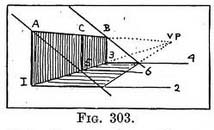 Practice for Fig. 303.—Draw the wall. Draw horizontal lines on the ground from its nearest and farthest base (1-2, 3-4), or from any other points. such as 5-6. From each point marked (where the wall touches the ground) raise uprights C B to the top of the wall (A, C, B). Decide on the slope of the sun's rays and carry them in parallel lines over the wall at each point marked. Where they meet the ground join them, to give the extent of the wall shadow. It is obvious that the rays from the sun when high in the heavens will be more vertically inclined, and the shadow consequently narrower, than when the sun is low and throws more horizontally inclined rays.
Practice for Fig. 303.—Draw the wall. Draw horizontal lines on the ground from its nearest and farthest base (1-2, 3-4), or from any other points. such as 5-6. From each point marked (where the wall touches the ground) raise uprights C B to the top of the wall (A, C, B). Decide on the slope of the sun's rays and carry them in parallel lines over the wall at each point marked. Where they meet the ground join them, to give the extent of the wall shadow. It is obvious that the rays from the sun when high in the heavens will be more vertically inclined, and the shadow consequently narrower, than when the sun is low and throws more horizontally inclined rays.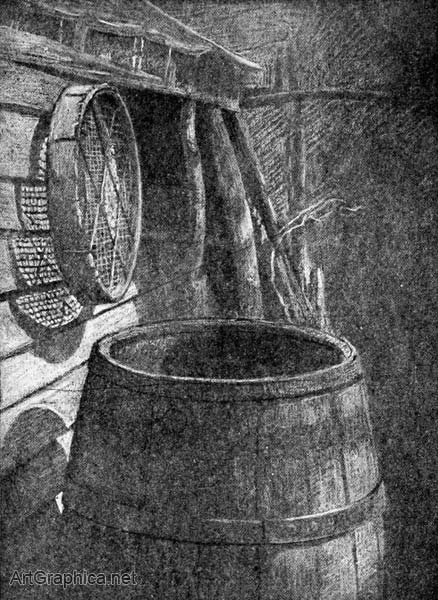
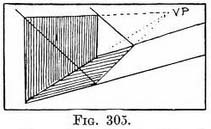 Practice (Fig. 305). - Draw the wall and the inclination of the sun's rays as before. Represent the slope of the ground by lines carried from certain points at the base of the wall, mark these certain points, and above each over the top of the wall take a sun's ray until it meets the ground.
Practice (Fig. 305). - Draw the wall and the inclination of the sun's rays as before. Represent the slope of the ground by lines carried from certain points at the base of the wall, mark these certain points, and above each over the top of the wall take a sun's ray until it meets the ground.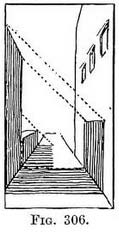 (3) Shadow from an object meeting an upright surface.
(3) Shadow from an object meeting an upright surface.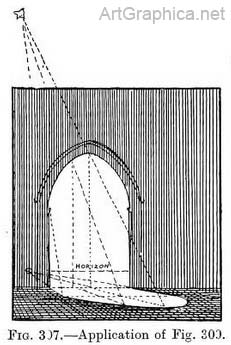 Practice for Fig. 307. — Draw the object. Mark the position of the sun. From it take lines over the top of the object to represent the sun's rays. Mark the ground under each spot where the rays touch the top of the object. The vanishing point for the shadows will be immediately under the sun on the horizon line. From the "shadow " V.P. take lines to the marks on the ground, and continue them till they meet the ray above each mark. Join each point so found in the same order as the original points of the object are joined.
Practice for Fig. 307. — Draw the object. Mark the position of the sun. From it take lines over the top of the object to represent the sun's rays. Mark the ground under each spot where the rays touch the top of the object. The vanishing point for the shadows will be immediately under the sun on the horizon line. From the "shadow " V.P. take lines to the marks on the ground, and continue them till they meet the ray above each mark. Join each point so found in the same order as the original points of the object are joined.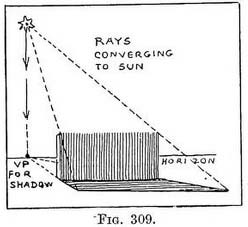 (3) Shadows on vertical planes. — In former cases we found that the " shadow " V.P. lies in the same plane as the surface the shadow is thrown on. Thus on level surfaces the " shadow " V.P. is on the horizon. Again, when the surface was sloping up we found the " shadow " V.P. at the same height as the " uphill " V.P. of the sloping surface. In both eases the " shadow " V.P. was directly under the sun. The " shadow " V.P. for shadows cast on upright planes is found to be at the height of the sun and immediately above the V.P. to which level lines on that plane recede. And so the " shadow " V.P. still retains its custom of being in the same plane as the surface on which the shadow is cast.
(3) Shadows on vertical planes. — In former cases we found that the " shadow " V.P. lies in the same plane as the surface the shadow is thrown on. Thus on level surfaces the " shadow " V.P. is on the horizon. Again, when the surface was sloping up we found the " shadow " V.P. at the same height as the " uphill " V.P. of the sloping surface. In both eases the " shadow " V.P. was directly under the sun. The " shadow " V.P. for shadows cast on upright planes is found to be at the height of the sun and immediately above the V.P. to which level lines on that plane recede. And so the " shadow " V.P. still retains its custom of being in the same plane as the surface on which the shadow is cast.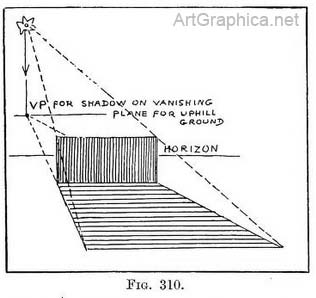 Practice for Fig. 311. — To draw a shadow on a vertical receding plane cast by a horizontal projecting surface. Draw the object, its V.P., the horizon, and the sun. Take a ray from the sun to a corner of any surface projecting from the upright. From the " shadow " V.P. carry a line to the junction of the upright surface with the projecting surface, continue the line till it meets the sun's ray. This determines the length of the shadow at that spot. Repeat the operation at each corner. The method need not be varied for vertical projections.
Practice for Fig. 311. — To draw a shadow on a vertical receding plane cast by a horizontal projecting surface. Draw the object, its V.P., the horizon, and the sun. Take a ray from the sun to a corner of any surface projecting from the upright. From the " shadow " V.P. carry a line to the junction of the upright surface with the projecting surface, continue the line till it meets the sun's ray. This determines the length of the shadow at that spot. Repeat the operation at each corner. The method need not be varied for vertical projections.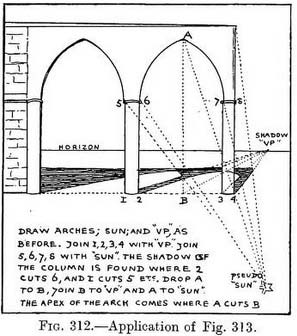 It is evident that the sun being unseen behind us, we can no longer draw rays from it—as in the last example to obtain the length of the shadows. To get over the difficulty we suppose the sun to be at the other end of a ray just so far below the horizon as the sun itself is above it.
It is evident that the sun being unseen behind us, we can no longer draw rays from it—as in the last example to obtain the length of the shadows. To get over the difficulty we suppose the sun to be at the other end of a ray just so far below the horizon as the sun itself is above it.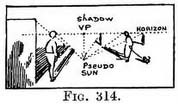 (B) Shadow thrown on an inclined plane. — When we drew the diagram of a wall on an uphill slope and the sun ahead of us we found the " shadow " V.P. to be immediately below the sun and on a level with the V.P. for the sloping ground (i.e. in the same plane with it). With the sun behind us we transpose it as in the last figure ; fix the " shadow" V.P. on a level with the " uphill " V.P. (as before), and place it immediately above the transposed sun.
(B) Shadow thrown on an inclined plane. — When we drew the diagram of a wall on an uphill slope and the sun ahead of us we found the " shadow " V.P. to be immediately below the sun and on a level with the V.P. for the sloping ground (i.e. in the same plane with it). With the sun behind us we transpose it as in the last figure ; fix the " shadow" V.P. on a level with the " uphill " V.P. (as before), and place it immediately above the transposed sun.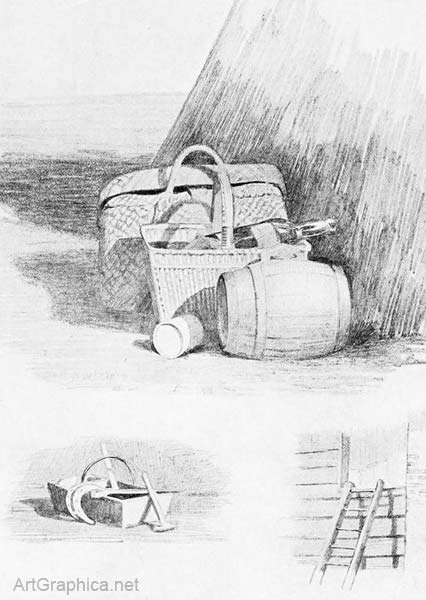
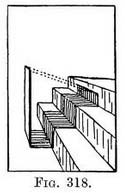 (1) Sun on one side.
(1) Sun on one side.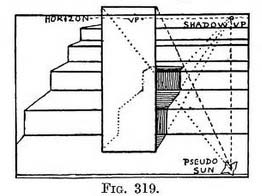 Sun on one side (Fig. 319). — Draw the rays touching the far corners. Drop verticals from the same points, and find out where they touch the ground by connecting near corners of slope with " level " V.P. Draw horizontal where verticals touch the ground. The junction of the sun's rays with horizontal line determines the length and width of the far end of the cast shadow ; join it to the near end of the slope.
Sun on one side (Fig. 319). — Draw the rays touching the far corners. Drop verticals from the same points, and find out where they touch the ground by connecting near corners of slope with " level " V.P. Draw horizontal where verticals touch the ground. The junction of the sun's rays with horizontal line determines the length and width of the far end of the cast shadow ; join it to the near end of the slope.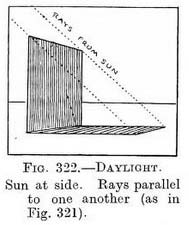 Compared with daylight shadows. — We found cast on level ground point towards the horizon distance that separates us from the sun.
Compared with daylight shadows. — We found cast on level ground point towards the horizon distance that separates us from the sun.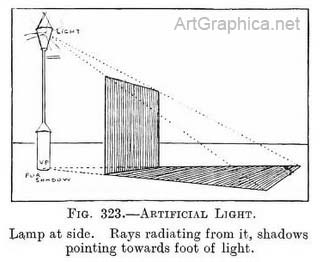 The same objects on the table when lit by a candle would have their shadows pointing towards a V.P. on the table candle-flame.
The same objects on the table when lit by a candle would have their shadows pointing towards a V.P. on the table candle-flame.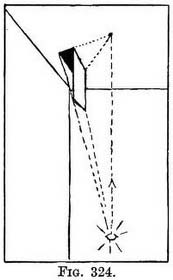 (2) Shadow thrown by an object projecting from the ceiling. — The " shadow " V.P. for objects projecting from a ceiling will be that point on the ceiling that is directly above the light.
(2) Shadow thrown by an object projecting from the ceiling. — The " shadow " V.P. for objects projecting from a ceiling will be that point on the ceiling that is directly above the light.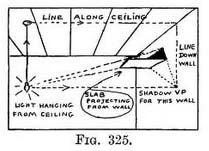 (3) Shadow on a vertical plane. — When drawing a shadow on the wall (Fig. 325), first find the " shadow " V.P., which must be on the wall, at the same height, and exactly opposite, the light. In other respects there is no difference between the working of this problem and the previous ones.
(3) Shadow on a vertical plane. — When drawing a shadow on the wall (Fig. 325), first find the " shadow " V.P., which must be on the wall, at the same height, and exactly opposite, the light. In other respects there is no difference between the working of this problem and the previous ones.







